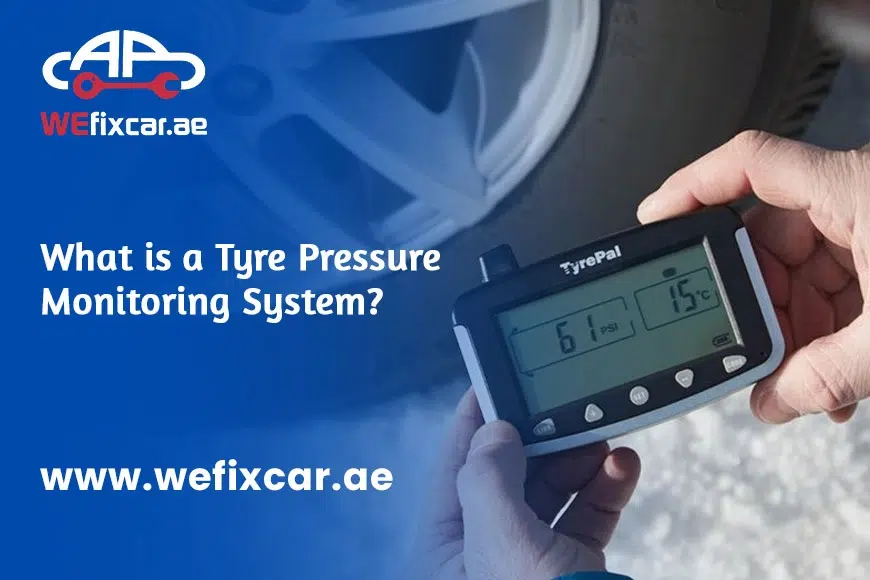What is a Tyre Pressure Monitoring System?
Almost every modern car now features a tyre pressure monitoring system, which is essential for safety, as it constantly measures the air pressure in your tyres. As part of your car’s safety system, it improves driving safety, helps save fuel, and prevents expensive roadside tire problems. We’ll describe TPMS here, explain how it functions, describe the different types available, and suggest why everyone in the UAE who drives or uses a mobile car service should be aware of it.
Let’s dive deeper into this essential system and how it can protect your vehicle and your life.
Need an expert tyre service in the UAE? Contact We Fix Car now for professional, on-the-spot mobile assistance.
Why Tyre Pressure Matters
Maintaining the correct tyre pressure is crucial for everyone’s safety and optimal driving performance. Under-inflated tyres cause increased heat and friction on the road, wear out faster, use more fuel, provide poor handling, and are more likely to blow out.
If you keep your tyres too inflated, they may no longer grip the road properly and will break down more quickly on one side. A tyre pressure monitoring system helps by maintaining your tyre pressure within the required range at all times.
Understanding the Tyre Pressure Monitoring System (TPMS)
This electronic system monitors tire air pressure and notifies the driver when it falls below a safe threshold. Usually manifested as a tire pressure alert or dashboard warning light, the warning demands quick action.
Modern TPMS systems fall into two main categories:
- Direct TPMS
Direct TPMS measures air pressure directly by using separate TPMS sensors installed inside each tire, usually on the valve stem of the wheel. The vehicle’s onboard computer receives real-time data from these sensors. The system sounds an alarm if the pressure falls below a predetermined threshold.
Benefits of Direct TPMS:
- Offers precise and real-time pressure readings.
- Able to identify which particular tire is deflated.
- Effectively detects slow leaks.
Considerations:
- Sensor batteries need to be changed, usually every five to ten years.
- More costly to replace or repair
- When changing tires, TPMS calibration is necessary.
2. Indirect TPMS
Indirect TPMS does not use physical pressure sensors. Instead, it uses wheel speed sensors or the vehicle’s anti-lock braking system (ABS) to track the rate of tire rotation. The system recognizes and flags underinflated tires because they rotate more rapidly and have a smaller diameter.
Benefits of Indirect TPMS:
- Less costly and simpler to keep up
- No sensor batteries are needed.
- Installation and maintenance made simpler.
Considerations:
- Not as precise as direct systems
- Unable to identify which tire is impacted
- needs to be manually reset following tire inflation or rotation.
How Does the Tyre Pressure Monitoring System Work?
Both varieties of TPMS aim to detect variations in air pressure and promptly notify the driver.
Here’s what typically happens:
- Phase of Monitoring: While driving, the TPMS continuously measures tire pressure.
- Detection: The system recognizes a deviation when the pressure in one or more tires drops below the level advised by the manufacturer.
- Warning: To notify you to take action, a tire pressure warning light or message appears on your dashboard.
No matter where you are, technicians can promptly detect and address TPMS alerts if you use mobile tire service UAE.
Common Issues With TPMS and How to Fix Them
- TPMS Sensor Failure
When installing tires, sensor batteries may run out, or the sensor itself may sustain damage. A malfunction warning is the result of this. In these situations, experts can install replacement or aftermarket kits.
- TPMS Calibration Errors
Inaccurate readings may arise if your system requires TPMS calibration, which may be necessary if you have recently had a tire rotation or change.
- False Alarms or Inconsistent Alerts
Extreme temperature fluctuations can occasionally cause TPMS alerts to appear. This is more typical in the climate of the United Arab Emirates. Such incidents can be reduced with routine tire care in the UAE.
Benefits of a TPMS
Purchasing a dependable pressure monitoring system, whether it is aftermarket or factory-installed, has the following benefits:
Enhanced Safety
One of the main reasons for tire blowout hazards, particularly when traveling at high speeds, is underinflated tires. By offering early warnings, TPMS helps you avoid mishaps.
Improved Fuel Efficiency
When tires are properly inflated, rolling resistance is decreased, which enhances fuel economy and reduces the environmental impact.
Extended Tyre Lifespan
By preventing uneven wear and tear, maintaining the proper pressure lowers the need for frequent tire replacements and repair expenses.
Better Vehicle Handling
In addition to improving traction and responsiveness, properly inflated tires also support other automotive safety systems.
When to Replace or Upgrade TPMS Sensors
The typical lifespan of TPMS sensors is five to ten years. However, driving circumstances and usage frequency significantly impact battery life. It makes sense to look into aftermarket TPMS options if:
- Your car lacks TPMS and is older.
- Your sensors are malfunctioning or exhibiting symptoms.
- You’re looking for a more sophisticated monitoring display.
Expert services, such as UAE mobile car services, can evaluate your existing TPMS and recommend suitable replacements.
Mobile TPMS Diagnosis and Repair Services, UAE
We Fix Car is aware of how crucial speed and convenience are to car owners in the UAE. For this reason, we provide comprehensive mobile vehicle services, such as:
- Diagnosed by TPMS
- Replacement of the sensor
- TPMS adjustment
- Inspection and inflation of tires
- Rotation and tire care
Our mobile tire service in the UAE guarantees that you’ll never be stranded due to a tire pressure alert or system failure, whether you’re at home, at work, or on the road.
How to Maintain Your TPMS System
Routine checks and professional servicing are the keys to a reliable TPMS.
Tips for TPMS Maintenance:
- Even with TPMS, check the tire pressure once a month.
- Regularly check for dashboard warning lights.
- After tire rotations or changes, schedule TPMS recalibration and replace sensor batteries as necessary.
- When replacing sensors, only use certified technicians.
By doing this, you reduce the risk of underinflated tire hazards by ensuring that your car’s tire sensors continue to function effectively.
Can You Drive with the TPMS Light On?
Yes, technically, but it’s not a good idea. One or more tires that are noticeably underinflated are indicated by the tire pressure warning light, which raises the possibility of:
- Inefficient use of fuel
- Decreased handling
- Risk of tire blowout
- Permanent damage to tires
Reduce your speed and locate a secure area to check your tire pressure if the light appears while you are driving. Alternatively, for a prompt and effective solution, contact We Fix Car’s mobile tire services.
Aftermarket TPMS Kits: Are They Worth It?
Aftermarket TPMS kits are an excellent choice if your car didn’t come with a factory-installed TPMS system or if you want additional features, such as real-time mobile notifications. Many of the kits available today are smartphone-compatible and provide customizable alerts, making them perfect for both private drivers and fleet owners.
They are:
- Economical
- Installing it is simple.
- Professional tire maintenance service providers are readily available.
Conclusion: Is TPMS a Necessity?
In the era of smart cars and increasing road safety concerns, a tire pressure monitoring system is not merely a luxury—it is a necessity. Having a functional TPMS, whether it’s an aftermarket kit or a factory system, offers you and your passengers safety, financial savings, and peace of mind.
Our mission at We Fix Car is to keep you informed, safe, and constantly moving. From TPMS checks to complete tire maintenance, UAE solutions, our knowledgeable staff provides dependable mobile auto services throughout the United Arab Emirates—all at your door.
Don’t wait for a dashboard warning light to alert you—get your TPMS inspected today and drive with confidence!
Frequently Asked Questions
- How do I know if my car has a TPMS?
Most cars manufactured after 2007 are equipped with TPMS. Look for a tire pressure warning light on your dashboard or refer to your vehicle’s manual.
- What should I do when the TPMS warning light comes on?
Check all tyres with a pressure gauge and inflate if needed. If unsure, call We Fix Car for mobile tyre repair services.
- Can TPMS sensors be repaired?
In most cases, damaged or dead sensors need to be replaced. We offer aftermarket TPMS kits and replacements at competitive rates.
- Is TPMS calibration necessary?
Yes. TPMS calibration is essential after tyre changes, rotations, or sensor
- How much does it cost to replace a TPMS sensor in the UAE?
Costs vary based on sensor type. On average, prices range from AED 150 to AED 300 per sensor, including installation by mobile services.



